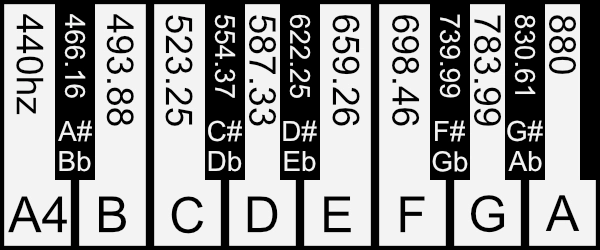What is Pitch?
Pitch is a very important part of musical composition. In western musical theory, pitch is a particular set of notes that have been chosen for their ease of playability and harmonically working with each other. There are other cultures with different note pitches used that give them a unique style like Indian scales or many african tribes with their own tonal systems. Music theory would need to be explained over many more chapters so I won't cover the details here. You can definitely look into music theory further as there are many good online resources. My reason for writing this chapter is to make you aware of pitch and how it works in a production context.

Scientific Pitch Notation
Scientific Pitch Notation (SPN), also known as International Pitch Notation, serves as the standard way to represent musical notes and it will be the primary method for representing pitch within the context of my blog. Familiarity with basic music theory renders SPN easily comprehensible. This standard facilitates seamless communication among musicians and producers, ensuring a clear understanding of the specific note under discussion.
The notation comprises two components: the note name and the note octave. Referring to the keyboard illustration above, the initial note is denoted as A4. Following SPN conventions, this signifies the note A played in the fourth octave. While I do not know the reasoning behind 440hz being the note A4, A cursory online search reveals that A0 was designated as such because it represents the lowest discernible pitch, resonating at a frequency of 27.5Hz.
More about pitch
Composition is the first step to writing a song and is just as important if not more important than how you record and mix your song. As a producer, there are compositional techniques you can use to create a certain atmosphere or groove that would not be possible in the mixing stage. Conversely, when you reach the mixing stage, there are effects and tools that can benefit from compositional knowledge to improve the song. For example, if you have a good understanding of pitch and musical scales, you may EQ a kick drum so it's fundemental frequency matches the key of the entire song. It's a small detail, but it can make a big difference to the impact the drums can have in the song.
In the audio realm, pitches are usually represented as a number of hertz (hz) which is how many cycles per second a tone is played at, this is also called the frequency. All instruments contain multiple frequencies in their sound, however the fundemental frequency (the lowest, loudest frequency) is considered the pitch of the sound. Humans generally have a hearing range from 20hz to 20,000hz, within that range, humans are most sensitive to 2,000hz to 5,000hz which can be a problem area when it comes to mixing music.
In music production, you may encounter the term "cents" in regards to pitch. Cents serve as a finer subdivision of the pitch spectrum between two successive notes. The interval spanning two notes, commonly referred to as a semitone, can be further delineated into 100 cents. This division facilitates precise pitch control and proves particularly useful in detuning musical instruments. The preference for expressing pitch in cents, as opposed to specifying the exact frequency, stems from the intricacy of representing frequency as a complex fraction. Utilizing cents allows for a more manageable and accurate input, circumventing the challenges associated with conveying precise frequency values.